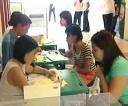Teacher Readiness To Use And Teach Using ICT
In SMJK Dindings, the necessary ICT infrastructures, the training, support, easy access policy and encouragement are actively promoted. Will the communities in school utilize the ICT tools to enhance the administrative, teaching and learning process? The school has established policies of encouraging the communities to utilize ICT tools to replace time consuming and repetitive manual tasks. Examination, students and library managements have gone digital. Students are able to check their examination results, view their merit and demerit records, and review the library borrowing history online in school or at home; certainly the ICT tools have become the prime enabling factor in these transformations. Students and teachers have used the ICT tools to their advantage and will continue to use it. Mr. Gerry Smith of River Oaks Public School said that if we can restructure the curriculum properly we would not have to worry about how the technology fits. Technology should become almost transparent in the learning process for students and teachers. The ICT tools will become pervasive tools and the prime enabler.
ICT Applications In SMJK Dindings
With the necessary ICT infrastructure, support, training, access and monitoring established, the ICT tools in SMJK Dindings are used to provide various services to the administrators, teachers and students. One of the notable applications is the online web-based School Management System (SMS). The other is the Squidguard, an Internet filtering system designed to prevent access to undesirable web sites.
School Management System (SMS)
School Management System (Web-based SMS) is an online information system for students, parents, teachers and administrative staff to conduct and process day-to-day business. It supports an information environment for all levels of school and staff to do reporting, data extraction, and information analysis. The School Management System (SMS) is an easy-to-use, integrated web application implemented in school to reduce time spent on administrative tasks so that school can concentrate on raising students’ achievements. The School Management System (SMS) is designed to integrate the four elements of an educational system – Management, Teachers, Students and Parents. It starts from a basic module with student and teacher portfolio to a complex open communication channel which facilitates synchronisation between the four elements with information and helps school to be efficient and effective. The School Management System (SMS) program is written in PHP, Java Applets and Open Sources database, PostgresSQL, running on Linux Operating System, accessing via web browsers.
Some of the components of School Management System (SMS) are:
· Real-Time Attendance with RFID
· Students Discipline
· Examination Management
· Library Management
· Co-curriculum Activity
Real-Time Attendance With Radio Frequency Identification (RFID)
Students Discipline
SMJK Dindings deployed web-based online Merit and Demerit System accessible to school administrators, teachers, parents and students themselves. An important feature of the online system is transparency, accountability and a sense of fair play in every punishment or reward meted out. Teachers and students can formally report any demerit or merit events to the disciplinary board, after investigation, marks for merit and demerit are awarded and students can view it online. Students with demerit exceeding 20 points, their names will be forwarded online to counselors to attend counseling sessions and appropriate disciplinary actions follow suit.
squidGuard
It is a combined filter, redirector and access controller plug-in for Squid. It is free, very flexible, extremely fast, easily installed and portable. In SMJK Dindings, squidGuard is used to filter Internet access based on the following parameters.
- Block access to some listed or blacklisted web servers and/or URLs
- Block access to URLs matching a list of regular expressions or word.
- Enforce the use of domain names/prohibit the use of IP address in URLs.
- Redirect blocked URLs to an “intelligent” CGI based info page.
- Have different access rules based on time of day, day of the week, date and different user groups.
Conclusion
To integrate ICT into school curriculum and to achieve the goal of information anytime and anywhere is only possible if there is a determined effort by the part of the school administration to achieve it. ICT can only become a pervasive tool in an effective learning process if the tool itself is transparent, widely available and accessible. If we are still struggling with the idea how to force the ICT to fit into school curriculum, it will become an obstacle rather than an enabler in the learning process. Judging from the various online applications running on the robust ICT infrastructure in SMJK Dindings and the culture of using ICT in the daily learning process is a testimony to the successful integration of ICT into school curriculum.

